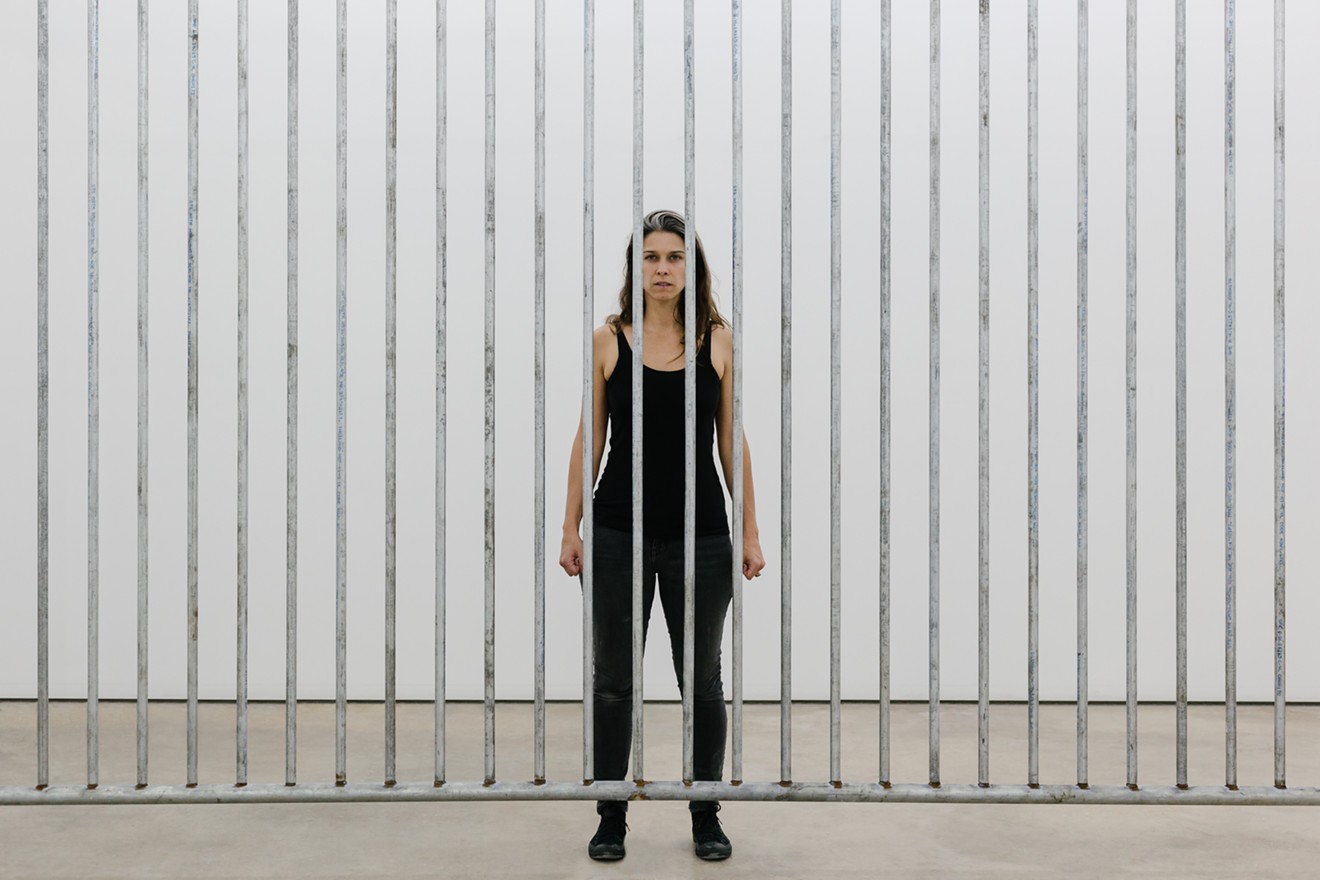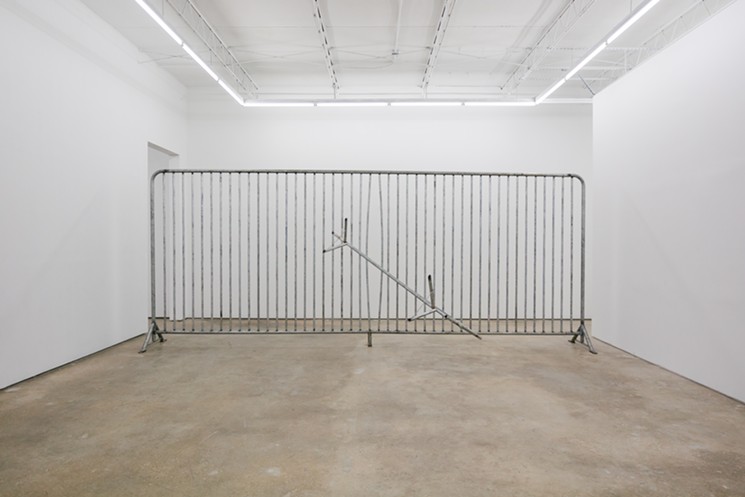Antonia Wright knows a thing or two about visceral experiences, and now she wants to put the spectator through one. The Miami-based performance artist has rolled naked in dingy, garbage-strewn alleys, walked thin ice to submerge herself in freezing water, and used her nude body as a force to burst through glass. In a change of pace, her latest work doesn’t involve her body. Instead, she is out to assault the viewer through the sudden shock of her kinetic sound, sight, and sculptural installation, Control.
At a recent locals preview of Control at Spinello Projects in Little River, Jesus Petroccini, the gallery’s former marketing director, found himself in a spot he called “the worst place you could be” for the experience. He stood in the front corner of a taped-off line on the floor of the gallery’s dimly lit main room. This was probably the last inch of safe space as determined by Wright for when metal crowd-control barricades, blasted from an air cannon, would begin flying at the 20 or so spectators. The barricades — those ubiquitous barriers that lock together to contain people, whether they're waiting in line for a concert or protesting — weigh less than you might think but can maim or even kill when used as a blunt-force instrument. For her installation, Wright has placed a giant, custom-made metal barricade between the audience and the projectiles.
Afterward, Petroccini called the experience worse than sitting at the front of a roller coaster, and the high-pitched scream he let go upon the release of the first projectile is a reverberating, shameful testament. To be sure, as secure as the large barricade appears to be, nothing feels entirely safe in that room. Spinello asked all participants to sign waivers releasing the gallery from liability if someone were injured or even killed while experiencing Control. A message on one door that led to the installation warned, “The performance is not recommended for those with the following conditions: epilepsy, heart condition, post traumatic stress disorder, sensitivity to light and sound.”
Light and sound are key to the piece. The long walk to the gallery is down a dimly lit hall with a metal lamp hanging at the end, the kind you see in police interrogation scenes in the movies. You turn a corner through some heavy blackout curtains and you’re in the main gallery, confronted by the giant barricade, which casts a sinister shadow through its bars. Another interrogation lamp lights the room in a dim orange glow from the center of the room. Two spotlights on either side add to the harsh light beamed at the audience. Ananda DeMello, gallery director at Spinello Projects, runs a thin metal cable from one end of the wall to the other, corralling the guests into those safe squares delineated on the floor, and announces, "If at any time you want to leave the performance, please ask, and I will come to you."
There's a cavernous echo in the room, and the lights are promptly turned off as DeMello walks away and into the darkness. The room is pitch black save for a small rectangular monolith of red light in the distance. It almost looks like a projection of red laser light. Before you can figure it out, the first barricade comes shooting out and slams against the bars. It’s so dark you don't see as much as hear it.
Sometimes viewers could glimpse arms bathed in the distant red glow of the slot from where the barricades shoot. They move things into place, as the canon sighs from the air pressure, loading up for another ejection. Before you can get any sense of rhythm of the assault, a strobe light flashes, creating an image of stillness in the dark. In that optical illusion of quiet are the ghostly images of the strewn barricades that have been jettisoned, including one poking precariously under the monstrous barricade. Despite the frozen image, the activity continues in the blinding blackness. There is a whistle of the pneumatic machine and a startling bang in the dark as an unseen barricade explodes into the space, shattering the false quiet from the psychological still image created by the momentary blindness.
This point marks the performance’s peak, revealing just how trapped and helpless the spectator is during Control. You can hardly reconcile what your eyes are seeing with what you’re hearing, let alone what’s real or not. This lack of control by the audience is exactly what Wright wants from her piece, which was inspired by the omnipresence of these barricades in Brooklyn, where she did a residency several years ago. It was around the time protests would spring up every time a young, unarmed black man was shot and killed in the United States, beginning in 2013 with the acquittal of George Zimmerman, the self-declared neighborhood watchman in Sanford, Florida, who was charged with the fatal shooting of 15-year-old Trayvon Martin. Then came the shooting of Michael Brown by a white police officer on August 9, 2014, in Ferguson, Missouri. After that was the death-by-chokehold of Eric Garner in Staten Island. The Black Lives Matter movement soon rose up against the militarized police response to the protests of these events.
All the while, Wright noticed the barricades. “It’s a type of control,” the artist says. “These things are everywhere. They’ve totally infiltrated our landscape.”
Wright isn't one to moralize, but she likes to shake people up by pointing out what is happening in society. It’s about awareness in the hidden meaning, a carryover from her studies as a poet. “It’s not a good or bad answer,” she continues. “It’s more, this is the world we’re living in right now. I don’t think the artist has to provide an answer. It’s just trying to take the vocabulary of visual that’s so prevalent now and recontextualize it into something different, so we could process it in a different way than how we’re normally seeing it.”
Control. Performances from 10 a.m. to noon Saturday, December 9, at Spinello Projects, 7221 NW Second Ave., Miami; 786-271-4223; spinelloprojects.com. The work will be on view Tuesday, December 5, through Sunday, December 10. Admission is free. RSVP via [email protected] is required to attend the performance.
[
{
"name": "Air - MediumRectangle - Inline Content - Mobile Display Size",
"component": "19274298",
"insertPoint": "2",
"requiredCountToDisplay": "2"
},{
"name": "Editor Picks",
"component": "17482312",
"insertPoint": "4",
"requiredCountToDisplay": "1"
},{
"name": "Inline Links",
"component": "18711090",
"insertPoint": "8th",
"startingPoint": 8,
"requiredCountToDisplay": "7",
"maxInsertions": 25
},{
"name": "Air - MediumRectangle - Combo - Inline Content",
"component": "17482310",
"insertPoint": "8th",
"startingPoint": 8,
"requiredCountToDisplay": "7",
"maxInsertions": 25
},{
"name": "Inline Links",
"component": "18711090",
"insertPoint": "8th",
"startingPoint": 12,
"requiredCountToDisplay": "11",
"maxInsertions": 25
},{
"name": "Air - Leaderboard Tower - Combo - Inline Content",
"component": "17482313",
"insertPoint": "8th",
"startingPoint": 12,
"requiredCountToDisplay": "11",
"maxInsertions": 25
}
]













